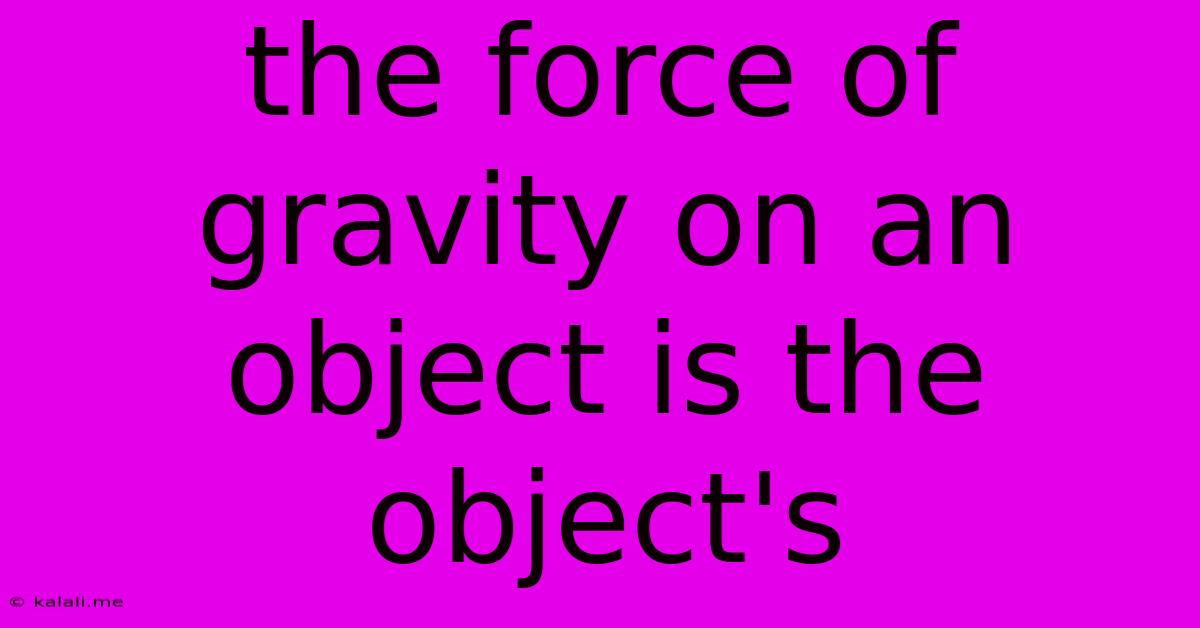The Force Of Gravity On An Object Is The Object's
Kalali
Jun 13, 2025 · 3 min read

Table of Contents
The Force of Gravity on an Object is the Object's Weight
Gravity, that invisible force that keeps our feet firmly planted on the ground, is a fundamental aspect of the universe. Understanding its effect on objects is crucial to comprehending many physical phenomena. This article will explore the relationship between gravity and an object's weight, clarifying a common misconception and delving into the nuances of this fundamental force. We'll uncover why the force of gravity on an object is, in essence, the object's weight.
Understanding Gravity and its Influence
Gravity, as explained by Newton's Law of Universal Gravitation, is the attractive force between any two objects with mass. The more massive the objects, and the closer they are, the stronger the gravitational pull. This principle governs the motion of planets around the sun, the tides on Earth, and even the seemingly insignificant fall of an apple from a tree. The Earth's immense mass exerts a significant gravitational force on all objects near its surface.
Weight: The Force of Gravity's Effect
The force of gravity acting on an object is precisely what we define as its weight. This is often confused with mass, which is a measure of the amount of matter in an object. While mass remains constant regardless of location, weight is dependent on the gravitational field strength. For example, an object with a mass of 1 kilogram on Earth will weigh approximately 9.8 Newtons (N), reflecting the Earth's gravitational acceleration (approximately 9.8 m/s²).
The Distinction Between Mass and Weight
It's crucial to distinguish between mass and weight. Mass is an intrinsic property of an object, representing its resistance to acceleration. It's a scalar quantity measured in kilograms. Weight, on the other hand, is a force – a vector quantity measured in Newtons. Weight is the result of the gravitational force acting on an object's mass. Therefore, the weight of an object can change depending on the gravitational field strength. For instance, on the moon, where the gravitational field is weaker, the same object would weigh considerably less, although its mass would remain the same.
Exploring Variations in Gravitational Force
The gravitational force isn't uniform across the Earth's surface. Subtle variations exist due to factors like the Earth's non-uniform density and its rotation. These variations, though small, can be measured with sensitive instruments. This means the weight of an object can slightly differ depending on its location on Earth.
Calculating Weight: A Simple Formula
The calculation of weight is straightforward. Using Newton's second law of motion (F=ma), where F represents force, m represents mass, and a represents acceleration, we can express weight (W) as:
W = mg
Where:
- W is the weight in Newtons (N)
- m is the mass in kilograms (kg)
- g is the acceleration due to gravity (approximately 9.8 m/s² on Earth)
This simple formula highlights the direct proportionality between an object's mass and its weight under a given gravitational field.
Conclusion: Weight as the Manifestation of Gravity
In conclusion, the force of gravity acting on an object is indeed the object's weight. Understanding this fundamental relationship is key to comprehending a wide array of physical phenomena. While mass remains constant, weight is a consequence of the gravitational interaction, varying depending on the strength of the gravitational field. Remember to distinguish between these two crucial concepts for a clearer grasp of fundamental physics. By understanding the interplay between gravity, mass, and weight, we can gain a deeper appreciation of the forces shaping our universe.
Latest Posts
Latest Posts
-
Which Of The Following Is A Percussion Instrument
Jun 14, 2025
-
The First 15 Elements Of Periodic Table
Jun 14, 2025
-
Which Of The Following Is An Inert Gas
Jun 14, 2025
-
Prime Numbers From 1 To 30
Jun 14, 2025
-
How Far Is Singapore From Equator
Jun 14, 2025
Related Post
Thank you for visiting our website which covers about The Force Of Gravity On An Object Is The Object's . We hope the information provided has been useful to you. Feel free to contact us if you have any questions or need further assistance. See you next time and don't miss to bookmark.